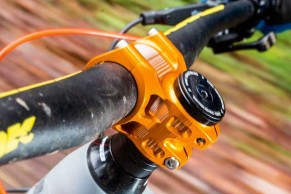7 changes we would make to a new mountain bike
You have just bought your new mountain bike, or you are thinking of doing so soon, and you think it will arrive to your hands perfectly set up. Really? Forget it, it is logical that you choose the right size on a new mountain bike, even that you adjust it or have it adjusted at the point of sale, but consider that every rider is a world and there are certain configurations, and certain adjustments on any new mountain bike, that you will have to make sooner rather than later. Here are seven of them.

7 settings for your new mountain bike
-
First, check the grips. You will notice that the feel of your new mountain bike grips is different, because the grips have been progressively adapted, or because each brand has its own grips. The fact is that it always takes a little while to adapt to the grip of a new mountain bike, so if you notice that it doesn't suit you at all, why don't you try putting on your usual grips? It will be a small change, much less traumatic, that will not add to all the different things that your new mountain bike brings. So change them for your usual ones, but only if your grips are in good condition, because if they need a replacement, get rid of this idea.

-
The pedals are another very sensitive element on any new mountain bike. Usually, bike sales are made without pedals for this reason, so the pedal and cove you already have will work for you. However, many new mountain bikes come with pedals. So it's up to you to disassemble and reassemble your old pedals. It is a fairly simple process, and it is not very difficult to replace some pedals. So do it and you'll feel more comfortable.

- Here's one you'll be eternally grateful for: tubelize your wheels. Maybe your new mountain bike already has tubelized wheels, but if not, tubelize them or ask your retailer to do so and you will receive it tubelized. It is something that does not cost too much and will solve many headaches in your trips. It will avoid more than one scare, for sure, so tubelize your new mountain bike.

- Change the tires. Yes, we know it may sound more controversial: if my new mountain bike has new tires, why should I replace them? Let's see how we can say this without hurting our sensibilities: let's say that a new mountain bike has tires that are not very strong, or less strong, in order for the whole set to be more visible and especially to weigh less. But surely there are better tires, and this will allow you to choose your favorite size of ball and the type of tire that best suits your rides and your profile as a cyclist. If you want, leave the standard ones until they wear out; or when you replace them, save them for a future emergency. But think about putting on better tires.

- A new mountain bike is a beautiful feeling. But something recurring is, after the first ride, getting scratched and you feel a little bad. Yes, it's a bit silly, because over time it's inevitable that you'll suffer scratches, rubbing, etc., if you really give your new mountain bike a ride. But the first scratch is like the first heartbreak: it always hurts a little more. So you can put protections on the frame, in its most sensitive and exposed areas, before the first ride. You will save scratches to the frame and the fork, at least the thickest and first ones, and it is something cheap.

- There is one piece on your new mountain bike that can certainly correct your posture on the bike. We're talking about the stem. If you carry out a biomechanical study and discover that your position has not adapted, even though the new mountain bike you have just bought is your size, the stem is an element that, by changing just one part, will further modify the geometry of the bike and the position of the rider.

- Finally, and this is gonna hurt a little bit, you can cut the handlebar. Yeah, it seems criminal to say you can cut the handlebar off a new mountain bike, imagine if it's carbon. But if you've already had a bike with the same size wheel, you'll know which handlebar length suits you best based on your previous experience. So why not make your new handlebar comfortable in its size and adapted to your experience of years?
RECOMENDADO

Guidelines for a perfect and safe tanned cyclist

How much money a cyclist can make in the Tour de France 2024?

Ketone, the drink of military origin for which Dumoulin quits the MPCC

Benefits of not drinking a drop of alcohol

Puncture-proof SmartMousse for mountain bike, do you need it?

Scott Spark 2021: models and prices

Riding with a new mountain bike
The first time you ride a new mountain bike, the sensations are unique. It's hard to describe to someone who hasn't had the chance how you can feel. It doesn't matter if you were a child, if 30 years have passed or if that new mountain bike was a piece of iron: it is something unforgettable.

In any case, as the years go by, you learn to know yourself better as a cyclist and to get comfortable on a bike. And then comes the second challenge: changing your bike, and here the concern is how you are going to adapt to a new mountain bike when you are already on yours. But don't worry, with these tricks and a little time, I'm sure that in months you will only remember your other bike, the old one, to say that you loved it but that it was tremendously uncomfortable.





